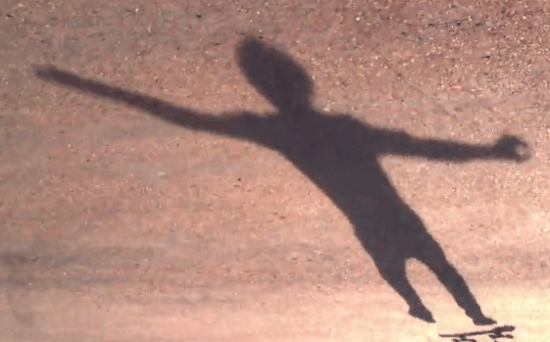If we shadows
By:
May 29, 2012
Via Aaron Cohen at kottke.org, this video by Joe Pease about bringing shadows to life. If it makes you think of Peter Pan, you’re not alone —Pease credits this essay on the role of shadow in J. M. Barrie’s play with inspiring his take on the dreamy, balletic rhythms of skating.
The video found me already thinking about the affordances of shadow, with a Places-hosted essay and gallery of images by the artist Eric William Carroll buzzing behind my eyes. Carroll makes blueprints of the shadows cast on sidewalk and path by trees — dreamy diazotypes on large sheets of the photosensitive paper traditionally used to reproduce building plans. Carroll ended up spending a month in residence at New Hampshire’s MacDowell Colony, where he made a tree-shadow panorama “so long that only a sports stadium could display it in its entirety.” The idea came to him not in the woods, however, but while watching the play of shadows on sidewalk:
I was raised in suburbia, in the Midwest, where we had trees in parks and yards and mall parking lots; but they hardly registered. Not until I encountered the sad specimens on the sidewalks of Brooklyn did I learn to appreciate the particular beauty of a tree. Just as Richard Avedon photographed his subjects in front of a stark-white backdrop to accentuate their individuality, I needed a concrete square in the city to recognize the tree’s essential form. The sidewalk was the great equalizer, letting each tree play on the same urban stage.
Carroll describes his project as an attempt to slow down the passage of time as it takes the form of roving shadow; the ephemerality of his medium ensures that his imaged obscurities will fade the way the daytime shadows fade with the coming of night, only on a much longer scale (and the nighttime, after all, is only the shadow of the earth). Time seems to be at work as well in Joe Pease’s skating shadows stretched in twilight’s lengthening embrace. Both projects are about the affordances of pavement as a medium — a quotidian material, even a blight on the land, which nonetheless illumines and estranges when viewed from the right angle. In Pease’s short film, pavement becomes a kind of parallel dimension of variegated textures and incidences of reflection, suspended mica and pockets of air shifting like mist.

Where do the shadows fall in network culture? We receive the internet in the form of emitted light — a glow which, as John Stilgoe points out, shares the reverie- and trance-inducing qualities of firelight and pyrotechnics. Gazing into emitted light, the shadows are always at our backs.
